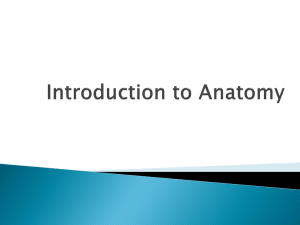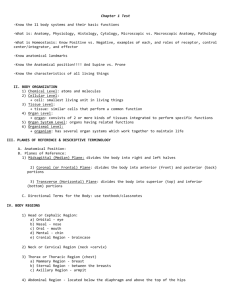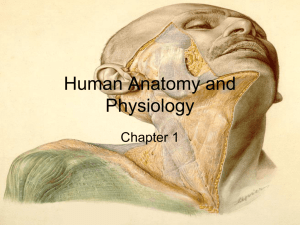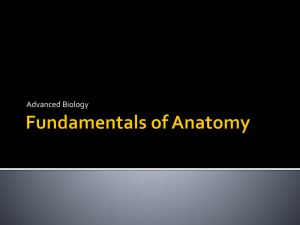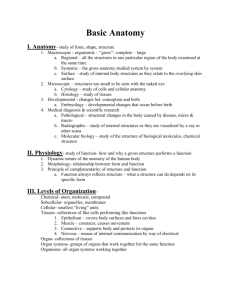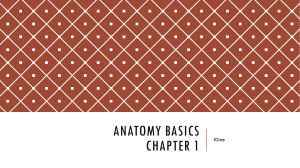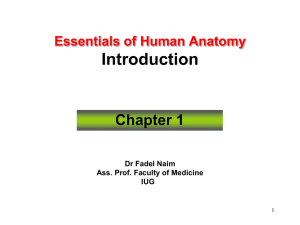Ch. 1 The Human Body: An Orientation
advertisement
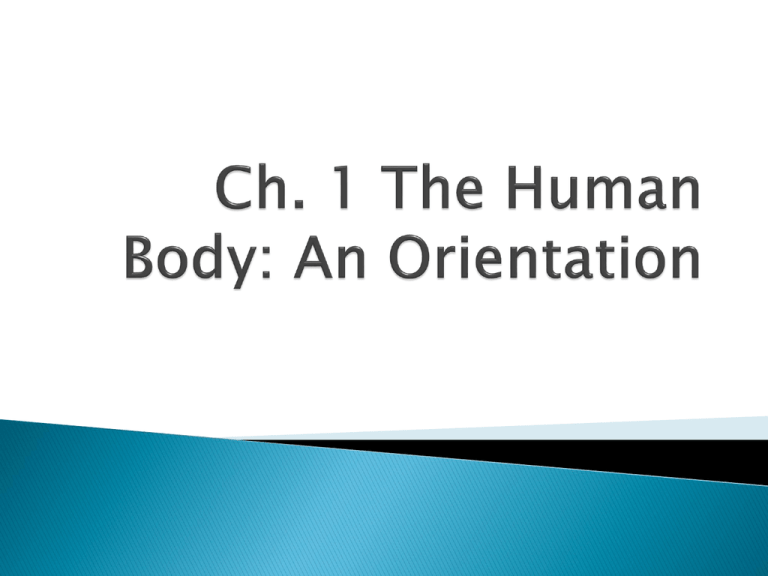
Reading pages 2-8 Anatomy is – ◦ the study of the structure of body parts and their relationships to each other. ◦ Means “to cut apart” Physiology is – ◦ the study of the function of the body’s structure. 4 branches of anatomy – ◦ ◦ ◦ ◦ Gross anatomy Microscopic Developmental Specialized branches Gross anatomy ◦ Macroscopic ◦ Study of structures large enough to be seen with the naked eye 3 categories of gross anatomy – ◦ Regional – study of all body structures in a body region ◦ Systemic – study of all structures in a body system body is studied system by system ◦ Surface – study of internal body structures as they relate to the skin Microscopic – ◦ Study of structures that are too small to see with the naked eye ◦ 2 categories of microscopic anatomy – Cytology – Study of cells Histology – Study of tissues Developmental – ◦ Study of the change in body structures over the course of a lifetime ◦ Embryology – Developmental changes that occur before and after birth Helps to explain birth defects Specialized branches of anatomy – ◦ Pathology – Study of structural changes associated with disease ◦ Radiology – Study of internal structures using specialized visual techniques ◦ Molecular – Study of biological molecules Essential tools for studying anatomy ◦ Mastery of anatomical terminology ◦ Observation ◦ Manipulation ◦ Palpation (feeling organs with your hands) ◦ Auscultation (listening to organ sounds with a stethoscope) Physiology – ◦ Studies the function or operation of organ systems ◦ Focuses/depends on Cellular or molecular level Principles of physics Complementarity of structure and function ◦ States that function is dependent on structure ◦ The form of a structure relates to its function Chemical – ◦ Simplest level of organization ◦ Atoms – Tiny building blocks of matter Combine to form molecules MEET THE ELEMENTS ◦ Molecules – Combine specifically to form organelles Organelles (nucleus, mitochondria, endoplasmic reticulum, etc.) are the basic unit of living cells The cell is the smallest unit of life (cellular level), and varies widely in size and shape according to the cells function. The tissue level is groups of cells having a common function. ◦ Epithelium, muscle, connective, and nervous Organ level – ◦ Specific structure composed of two groups of tissues that work together to perform a specific function Lungs – epithelial tissue and connective tissue Organ systems – ◦ ◦ Groups of organs that work closely together to accomplish a specific purpose Cardiovascular system Heart, lungs, blood vessels, and blood all work together to keep the body oxygenated The organismal level is the total number of all structures working together to promote life. Maintaining boundaries – ◦ Allows the body to maintain separate internal and external environments ◦ Allows the body also maintain separate internal chemical environments ◦ Cells are chemically separate from the body by the plasma membrane ◦ Internal environment kept separate by integumentary system (skin) Movement – ◦ Allows transport of molecules within the body – Blood Food Urine ◦ Muscles = movement Responsiveness – ◦ Irritability ◦ Body’s ability to detect changes in the internal or external environment and be able respond to the stimuli ◦ Reflex Digestion – ◦ Process of breaking down food into molecules that the body can use ◦ Food is broken down into tiny molecules that can be absorbed into the blood and used by cells Metabolism – ◦ All chemical reactions that occur in the body ◦ Breaking down substances (catabolism) ◦ Synthesizing more complex substances from simple substances (anabolism) ◦ ATP production ◦ Regulated by hormones, digestion, and oxygen availability Excretion – ◦ ◦ ◦ ◦ Process of removing waste (non-useful substances) Digestive system Urinary system Respiratory system Reproduction – ◦ Process by producing more cells or organisms ◦ Meiosis and mitosis – one cell divides to produce identical daughter cells Growth – ◦ The increase in size of body parts or the whole organism ◦ Usually accomplished by increasing the number of cells ◦ Individual cells can increase in size when not dividing Organ systems work cooperatively to promote the well-being of the entire body Check out pages 6 and 7 Get into a group of 3 and complete a foldable of the 12 organ systems. Must include: ◦ Name of system ◦ Organs involved ◦ Brief description of what the system does (do your best to put the book description into your own words) Survival needs = ◦ Factors that are required to maintain life ◦ Include – Nutrients Oxygen Water Body temperature Atmospheric pressure Nutrients – ◦ Chemical substances used for energy and the rebuilding of cells ◦ Plant-derived food = Carbohydrates – bodies energy source Minerals & vitamins – required for chemical reactions & oxygen transport ◦ Animal foods = Proteins – fuel for the body but less energy than carbs & help for cell structure rebuilding Fats – cushion organs, energy reserve, and form insulating layers Oxygen – Water – ◦ ◦ ◦ ◦ ◦ ◦ ◦ ◦ ◦ ◦ Human cells need oxygen to perform reactions Cells reactions are oxidative – requiring oxygen Transported by red blood cells Air = 20% oxygen – transported to cells through the respiratory system & by blood cells Most abundant chemical substance in the body 60-80% of body is water Chemical reactions need watery environment to perform Provides base for body secretions and excretions Acquired from food and liquids Lost from evaporation through the lungs, skin & excretions Normal body temperature – ◦ Must be maintained for chemical reactions to take place ◦ Body temp must stay above 98ºF for chemical reactions to occur at a normal rate ◦ Body temp that gets too high can cause chemical reactions to occur at such a rapid rate that the body can’t continue to function ◦ Most body heat is generated from the muscular system Atmospheric pressure – ◦ Force the air exerts on the surface of the body ◦ Breathing and gas exchange ◦ High altitudes = lower atmospheric pressure = lower cellular functions ◦ Must be present in appropriate amounts or cellular functions can be slow or excessive pressure can cause cellular damage Reading pages 8-12 Homeostasis is the ability of the body to maintain a relatively constant internal environment, regardless of environmental changes. ◦ A dynamic state of equilibrium or balance ◦ Internal conditions vary but always remain within normal limits ◦ Communication throughout the body is essential Accomplished by the nervous and endocrine systems Homeostatic control mechanisms – ◦ Components – Variables – the regulated factor or event Receptor – structure that monitors changes in the environment sensor that responds to changes or stimuli sends info to the control center Control center – Structure that determines the set point (level or range) for a variable Analyzes input Coordinates an appropriate response to the stimuli Effector – Structure that carries out the response directed by the control center Most homeostatic control mechanisms are negative feedback mechanisms. A negative feedback mechanism causes the variable to change in a way that opposes the initial change. ◦ Cause the variable to change in the direction opposite to that of the initial change – returns it to its “ideal” value ◦ Ex. Thermostat = sets temp & houses both the receptor & control center – temp is set and when the temp drops the heating system turns on (effector) – when the temp is reached the thermostat is triggered off Both the nervous system and the endocrine system are important to the maintenance of homeostasis. The goal of negative feedback mechanisms is to prevent sudden, sever changes in the body. ◦ Examples: Body temperature, withdrawal reflex, control of blood volume by ADH, heart rate, blood pressure, rate and depth of breathing, and blood levels of O2, CO2, and minerals A positive feedback mechanism causes the variable to change in the same direction as the original change, resulting in a greater deviation from the set point ◦ Response enhances or exaggerates the original stimulus so the activity (output) is accelerated ◦ Said to be positive because the changes occur in the same direction as the initial disturbance ◦ Control infrequent events that don’t require continuous adjustments Positive feedback mechanisms typically activate events that are self-perpetuating ◦ Once initiated have a amplifying effect Most positive feedback mechanisms are not related to the maintenance of homeostasis ◦ They can race out of control – so they are rarely used to promote day to day life ◦ Examples: Blood clotting Enhancement of labor contractions – oxytocin – intensifies labor contractions Homeostatic imbalances often results in disease As we age our control systems become less efficient & stable Positive feedback mechanisms can become out of control causing illness and diseases (some aspects of heart failure are due to out of control positive feedback mechanisms) Reading pages 12-19 Anatomical position – ◦ A position in which the body is erect (standing), feet are slightly apart, palms face forward, and the thumbs point away from the body. ◦ In anatomical position, right and left refer to the right and left sides of the person being viewed. ◦ Anatomical position is always assumed Directional terms – ◦ Used to explain exactly where one body part is in relation to another ◦ Very specific terminology 2 divisions of regional anatomy – ◦ Axial – Makes up the axis of the body Includes head, neck, and trunk ◦ Appendicular – The appendages of the body that attach to the axis of the body Includes upper and lower limbs ◦ Regional terms designate specific areas within the axial and appendicular divisions. Designates specific areas within the body divisions Body planes are flat surfaces that lie at right angles to each other A section is named for the plane along which it is cut ◦ Sagittal plane = sagittal section Body planes = ◦ Sagittal ◦ Frontal ◦ Transverse Sagittal – ◦ A vertical plane that separates the body into right and left halves Median or midsagittal plane – Sagittal plane that lies exactly along the body’s midline Parasagital –Sagittal plane that lies offset of the midline Frontal – ◦ A vertical plane that separates the body into anterior and posterior parts ◦ Also called a coronal plane – Divides the body across the crown of the head Transverse – ◦ A horizontal plane that runs from right to left ◦ Divides the body into superior and inferior parts Sections – ◦ Cuts made along specific planes ◦ Transverse – Cross section Made along a transverse plane ◦ Oblique – Cuts made at angles between the horizontal and vertical planes Body cavities – ◦ Spaces within the body that are closed to the outside and contain the internal organs ◦ Dorsal body cavity – Space that houses the central nervous system Cranial – Is within the skull & houses the brain Vertebral – Spinal cavity Cavity within the vertebral column houses the spinal cord Ventral body cavity – ◦ Anterior to & larger than the dorsal body cavity ◦ Thoracic – Superior division Surrounded by ribs and muscles Pleural cavities – Houses lungs Mediastinum – Contains the esophagus & trachea Pericardial cavity - Encloses the heart Ventral body cavities cont. – ◦ Abdominopelvic – Inferior division of the ventral body cavity Separated from thoracic by the diaphragm Abdominal cavity – Contains the stomach, intestines, spleen, and liver Pelvic cavity – Inferior part w/ in the bony pelvis Contains the bladder, reproductive organs, & the rectum Serous membranes are also called serosae Serous membrane contains… ◦ Parietal – Lines the cavity walls Named for specific cavities in which it is associated ◦ Visceral – Covers the outer surface of organs in the cavity Named for the specific organ in which it is associated Serous membranes secrete & are separated by a thin layer of lubrication fluid = serous fluid ◦ allows organs to slide without friction along cavity walls and between each organ Helps to divide into smaller areas for study Figure 1.11a Oral and digestive – mouth and cavities of the digestive organs Nasal –located within and posterior to the nose Orbital – house the eyes Middle ear – contains bones (ossicles) that transmit sound vibrations Synovial – joint cavities Figure 1.13


